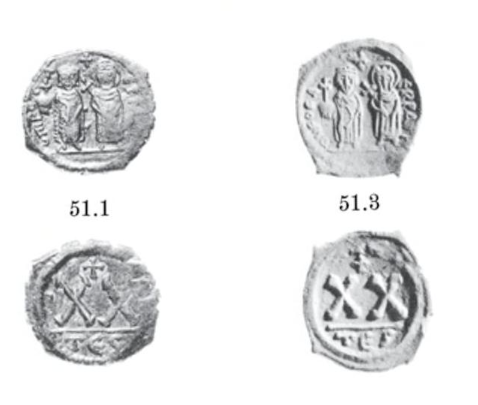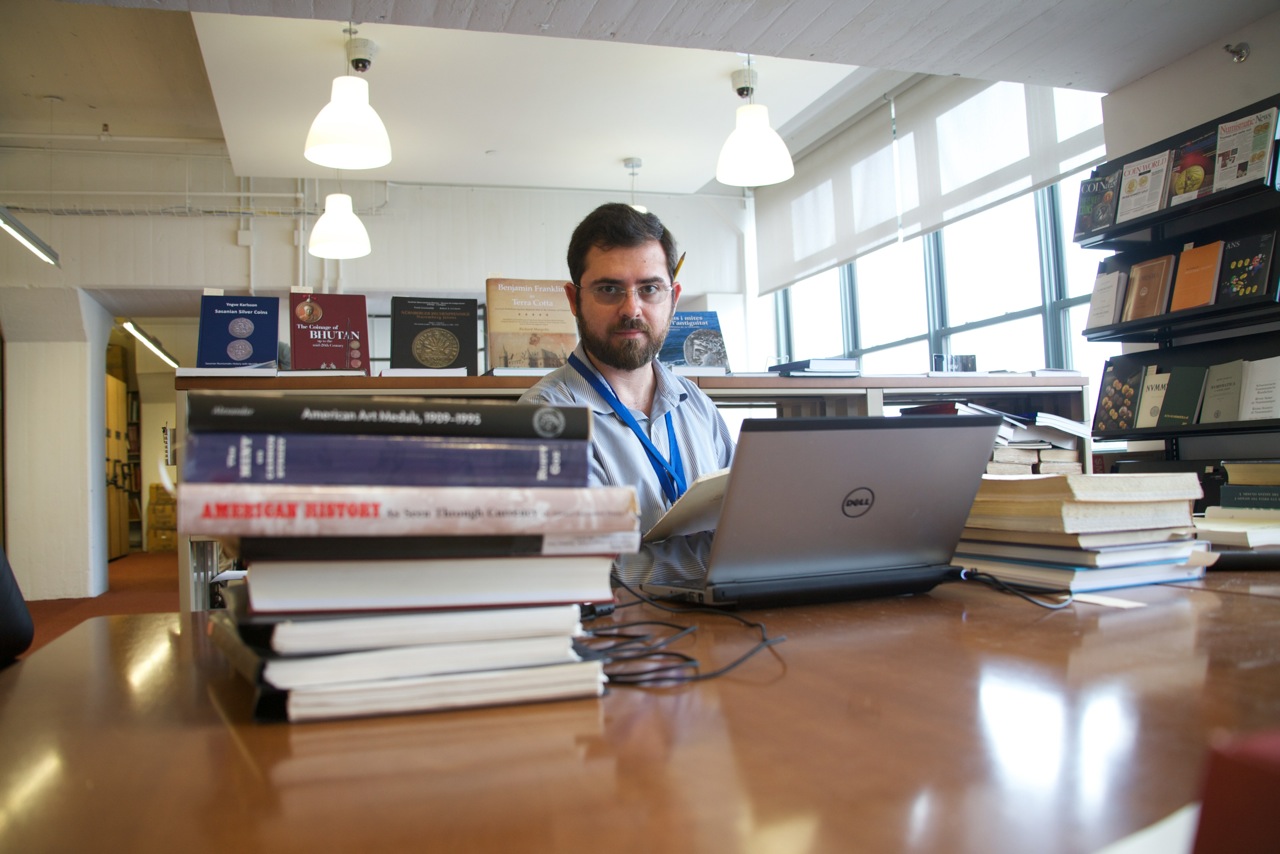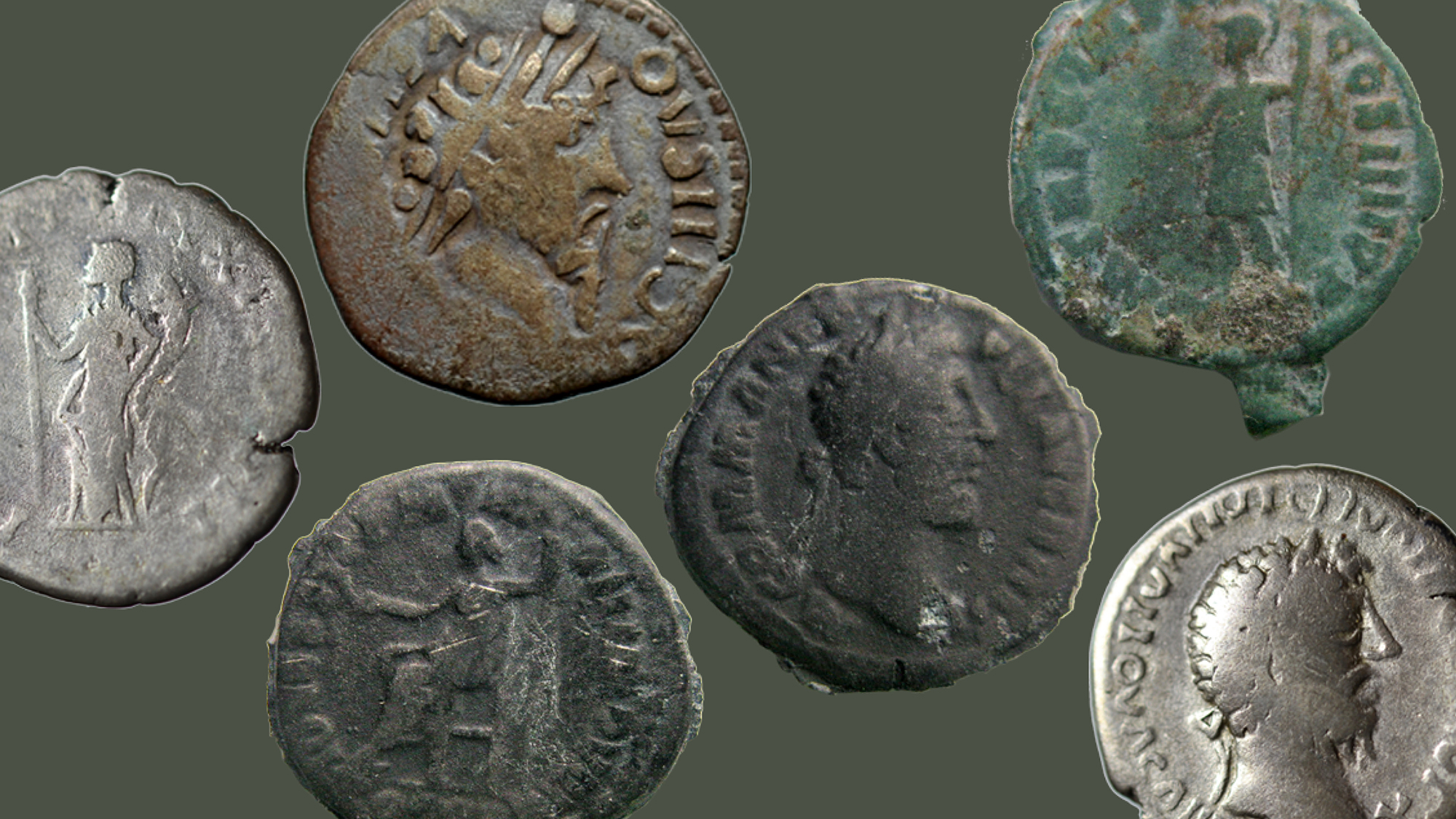The Changing Iconography of Byzantine Gold Coinage
The Byzantine Empire, which lasted more than a thousand years, had one of the most monetized economies in medieval Europe. The coinage of Byzantium was an essential element of this unique civilization, which preserved Roman law and state structures and inherited not only the Hellenistic cultural tradition, but also a powerful organizing force—Christianity.
From the beginning Byzantine coins followed the Late Roman iconographic tradition, which took shape gradually under Constantine I (306–337). At the accession of the emperor Anastasius I (491–518) there were three denominations of gold coin—the solidus (in Greek nomisma) and its fractions, the semissis (half) and tremissis (third)—along with a tiny copper coin known as a nummus. The typical obverse of the Byzantine solidus at the end of fifth century and beginning of the sixth was a three-quarter frontal bust of the emperor, usually in armor and holding a spear. The reverse type depicted Victory in profile supporting a cross. However, the next Byzantine ruler, Justin I (518–527), modified the obverse image to a full-face frontal bust and the image of Victory on the reverse was replaced by a facing angel.
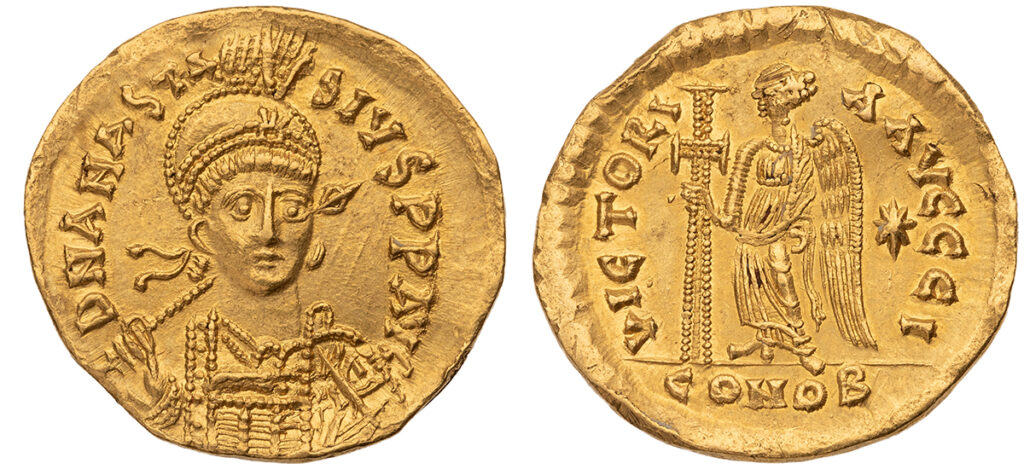

Under Justinian I (527–565) the emperor’s appearance was slightly changed and the spear in his right hand was switched to a globus cruciger, which symbolized the divinely bestowed universal power of the emperor.

Justin II (565–578) chose a seated personification of Constantinople for the reverse of his solidi, while Tiberius II (578–582) used a simpler image of a cross on steps as the reverse type for his solidi. This cross supposedly symbolized a monumental cross that Theodosius II erected on Golgotha around 420.


The images of the emperor on coins in the late fifth and sixth centuries didn’t have any personal features. However, the beginning of the seventh century saw great modifications. A more individual portrait was introduced under the emperor Phocas (602–610). He appears on his coins as a bearded man (his predecessors are nearly always shown clean-shaven) with shaggy hair, holding a cross rather than a globus cruciger. The reverse of these solidi bears a standing angel, similar to that on the solidi of Justin I.

Under Heraclius (610–641) the coinage reflected the arrangements that the emperor made for his succession. He appeared first with his eldest son Heraclius Constantine and later with his second son Heraclonas, and finally both sons appear standing on each side of their father.

Strong elements of portraiture are present on the coins of the late seventh century. The monetary issues of the first reign of Justinian II (685–695) portray the young emperor with youthful features. When the general Leontius (695–698) deposed the emperor and exiled him to the distant Byzantine themes of Cherson (modern Sevastopol in Crimea, Ukraine), the coins portray the fat, bearded Leontius instead.


At the end of the seventh century one of the most important changes in Byzantine coin design occurred. The image of Christ Pantocrator (depicting Christ in the role of ruler and judge), first appeared on the solidi of Justinian II’s first reign (685–695). It is a realistic facing bearded bust, with the right hand raised in benediction and holding a Gospel book in the left. This type is derived from well-known Byzantine icons and mosaics. Interestingly, when Justinian II placed this image on the obverse of his coins, he moved his own image to the reverse, where he is shown holding a cross borrowed from earlier types. A very different portrait of Christ appeared on gold coins during Justinian II’s second reign (705–711). It represents Christ in a formal linear style as a youthful man with closely curled hair. Some literary sources suggest that this depiction probably originated in Palestine.

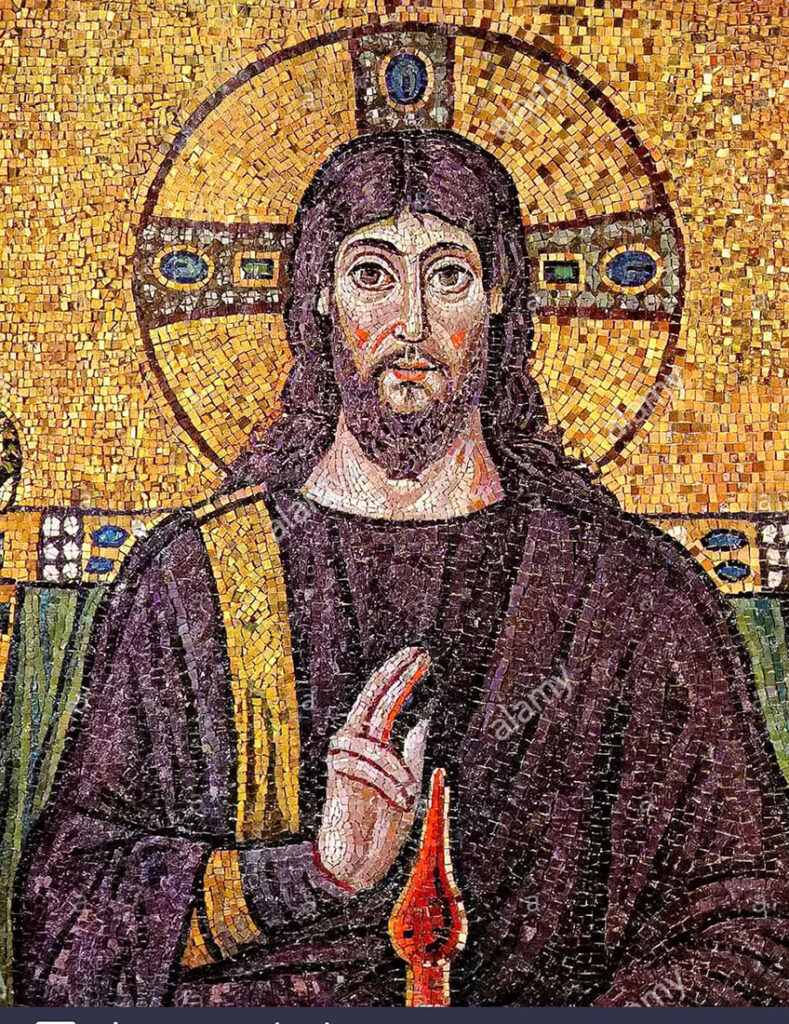

The concept of Christ Pantocrator is an Eastern Christian view that differs from the more Western view of Christ the Redeemer. The idea of a divine ruler of universe was deeply rooted in Greek culture, reaching back to Zeus, who bestowed the right to rule on Hellenistic kings and was also considered a divine judge.
The individualized portraiture of the seventh century was replaced again, during the so-called Iconoclast period when worshiping of icons was prohibited (726–843), by imperial busts drawn in a linear manner without any attempt at portraiture. The previous cross on the reverse was replaced by images intended to promote dynastic continuity. Most often, the emperor’s son was elevated to co-emperor and depicted on the reverse, although some coins in the eighth and ninth centuries show ancestors of the emperor instead. The coinage of this period is characterized by a high degree of simplification.

In the mid-ninth century, new changes in the coin types occurred, connected with the restoration of icon worship. Michael III (842–867) reintroduced a bust of Christ on his solidi, similar to the one on the coins of Justinian II. In 867 Basil I, the founder of the famous Macedonian dynasty, replaced the image of Christ Pantocrator with an image of Christ enthroned. From this time on, images of Christ appeared regularly on Byzantine coins.
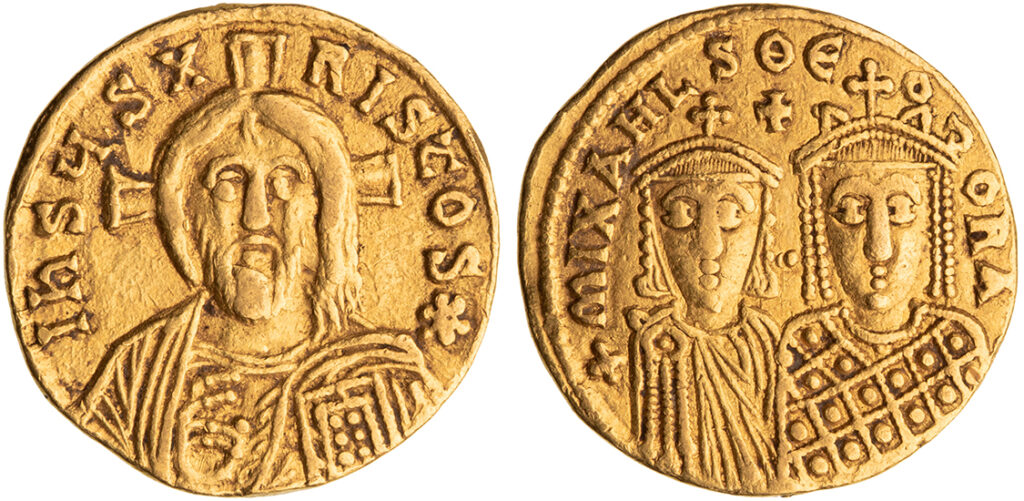

The image of Christ seated on a throne with the inscription “rex regnantium” (“king of those who rule”) had a special meaning. It was intended to convey that Christ and the emperor shared power and that God rules his earthly subjects through the emperor, his chosen instrument, who should be venerated as God’s representative.


Some coins of the tenth and eleventh centuries have individualized portraits rather than a generic imperial figure, such as those of Leo VI (886–911) and his son Constantine VII (913–959), but usually they do not. The rare gold coin of Zoe and Theodora, the daughters of Constantine VII and the last of the great Macedonian dynasty (1042), for example, lacks any recognizable features, even though these two sisters were said to be very different in personal appearance.

The absence of personalized portraiture in Byzantine coin iconography was connected with a belief that the imperial image represented the emperor’s “eternal body” rather than his physical features. The undifferentiated imperial images on most Byzantine coins are a depiction of this religious significance.
The obverse of the solidus of Zoe and Theodora bears an image of the Virgin, with hands raised in the traditional gesture of prayer, with a medallion of the infant Christ. The image of the Virgin was introduced by Leo VI (886–912), who was especially devoted to her cult After occasional appearances in tenth-century coinage, this image reappeared in subsequent reigns, either alone or conjointly with emperor.


In the eleventh century, when the Byzantines came under severe pressure from the Seljuk Turks in Asia Minor, Michael IV (1034–1041) took the unprecedented step of debasing the solidus. Along with the debasement, the form of the coins changed significantly under Constantine IX (1042–1055). They were struck in a concave shape called “scyphate”, a term found in Italian documents of the eleventh and twelfth centuries, meaning cup-shaped. Usually the image of Christ was on the convex side and a representation of the emperor on the concave side.


Despite the declining fineness of the gold coins, their designs remained varied and interesting. A particularly unusual type appears on the gold nomisma of Romanus IV (1069–1071), showing Christ between the emperor and the empress. This type is stylistically similar to an ivory relief that represents Romanus II (945–963) and Eudoxia crowned by Christ.


In the disastrous years after the Battle of Manzikert (1071), the fineness of the solidi was reduced from 24 karats to 8 karats. In the 1080s, during the early years of Alexius I (1081–1118), the amount of gold in the solidus dropped almost to none.

Alexius I accomplished a major monetary reform in 1092, introducing a new good-quality gold coin, called the hyperpyron, though the fineness was set to only 20½ karats instead of the traditional 24 karats. This issue was accompanied by an electrum piece, the aspron, which was worth one third of the hyperpyron. The obverse type of these post-reform coins usually shows images of Christ or the Virgin, while the reverses normally show a standing emperor, or the emperor accompanied by Christ or the Virgin. The image of the emperor with the Virgin was later reflected on the Venetian grosso.


The empiresurvived the disaster of 1204, when Constantinople was captured and barbarically plundered by crusaders and temporarily became the seat of the Latin Empire (1204–1261). However, the hyperpyra struck by the Greek emperors in exile were gradually debased,falling to 18 or even 16 karats.
In 1261, Emperor Michael VIII Palaeologus (1259–1285) recovered Constantinople. He reduced the hyperpyron to 15 karats but introduced a new representation of the Virgin, rising from the wall of Constantinople. With this new type the emperor proclaimed the return of the Byzantine Empire to the capital; it became the norm for the obverse of hyperpyron until the end of the gold coinage in the mid-fourteenth century. The reverse of Michael’s gold coins shows the emperor kneeling before Christ, accompanied by the Archangel Michael. This type served to declare the support of heaven for the emperor’s power.

Michael VIII’s son Andronicus II (1285–1330) introduced a new type depicting the emperor bowing down before Christ on his hyperpyra. This image is well known from a famous mosaic of the late ninth century in the Hagia Sophia (“Holy Wisdom”) cathedral in Constantinople, showing Leo VI (886–912) performing this act of proskynesis before Christ. The use of this type on the coins of Andronicus II emphasized the Palaeologan dynasty’s claim of connection with God. The fineness of the hyperpyron was reduced to 12 karats during the reign of Andronicus.


The last hyperpyron of traditional design, which effectively marks the end of imperial gold coinage, was struck in the mid-fourteenth century. At that time the Byzantine Empire was under enormous pressure from the Turks, and its economic system had been irrecoverably disrupted. During the empire’s last decades, its borders had shrunk until they included only Constantinople itself and parts of southern Greece. In spring of 1453 Sultan Mehmet II began his attack on the capital. The battle raged for seven weeks and the end came on May 29, 1453. On that day, after a thousand years of existence, the Byzantine Empire disappeared from the political map. However, the living memory of the vanished empire, as well as Byzantine tradition inherited centuries earlier from the Roman Empire, contributed to the dawning Renaissance.


